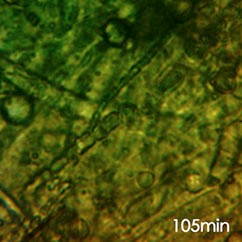GP-AB Polyphagous shot hole borer - PSHB BEETLE
1. Beetles.
In an in-house experiment using a 55cm section of a Box Elder tree branch some 3500 beetles were extracted through entrance of exit holes bored by the beetles. However, an examination of cross sections of infected timber clearly indicate that the majority of beetles commenced boring from the inside and continued boring random tunnels for the duration of their life cycles. In respect of these beetles, exit holes were clearly absent. It can therefore safely be assumed that the vast majority of beetles were active inside the tree and assuming that 75% of beetles worked inside the tree, a more realistic number of beetles mortality on the said trunk section would be 14 000.
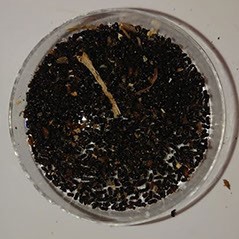
BEETLE COUNT AFTER DAY 1 = 1304
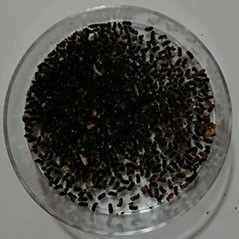
BEETLE COUNT AFTER DAY 2 = 691

DEAD BEETLES DISCHARGED AROUND THE TRUNK
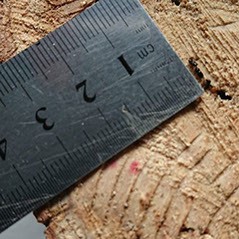
BEETLES DYING 4 CM INSIDE THE TREE TRUNK
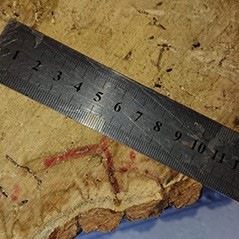
BEETLES DYING 10 CM INSIDE TREE TRUNK
- Further, the number of breeding cycles of these beetles can be as many as 7 in a single calendar year and it has been calculated that one female produces as many as 1 billion off-springs per year. As the male borer cannot fly, it is confined to its place of birth. It therefore follows that the tree will be riddled with possibly many millions of borer tunnels. These wounds impede normal plant functioning and vitality. A wound repair process is essential, and it is possible to help trees with this recovery process.
- Fungi. As beetles bore their tunnels, they leave behind trace elements of fungi (mainly Fusarium). The fungi are mainly found in the sapwood of Xylem section of the trunk. The xylem comprises the youngest layers wood. Its network of thick-walled cells bringing water and nutrients up from the roots through tubes inside of the trunk and the leaves and other parts of the tree. As the tree grows, xylem cells in the central portion of the tree become inactive and die. These dead xylem cells form the tree's heartwood.
- The Fusarium serves the purpose of feeding the PSHB larva until they are in turn transformed into adult beetles. Thereafter beetles continue to live off the Fusarium fungus. For the Fusarium to effectively grow, large quantities of moisture are necessary, and in the process the upper portions of the tree are robbed of its natural water supply. It is important to eradicate the fungal growth. Because larva is entirely dependent of Fusarium fungi for its growth and livelihood, the absence of Fusarium means there will be little or no larva survival and thus much reduced future beetles, and without Fusarium the beetles will starve and die.
- Fungal Spread. The Fusarium does not limit its growth to breeding spots but continue to spread throughout the sapwood section and eventually blocks all transport of nutrients and water to the upper tree sections and the consequent result is that the tree will die. A much wider level of Fusarium eradication is essential.
- A key feature for a tree's survival will be to enhance the cellular activity of the Cambium. The cambium is a very thin layer of growing tissue that produces new cells that become xylem, phloem or more cambium. Every growing season, a tree's cambium adds a new layer of xylem to its trunk, producing a visible growth ring in most trees. The cambium is what makes the trunk, branches and roots grow thicker. It is possible to enhance the cambium's activity through specialized nutrients.
the GP technology
This far, researchers worldwide, and particularly in the USA could not find a suitable product of mechanism for the large-scale treatment of trees. The main reasons for their inability to find solutions are:
- Inability of treatment of penetrate through the various layers of timber but also through the related barrier functions.
- The various layers are interspersed by barriers of hydrophobic and hydrophilic nature, which requires an amphiphilic approach.
- Most toxins have not been designed for its systemic functioning, or at best display limited systemic activity, and therefore have limited application for this particular problem.
- Drug resistance is a continuous problem, and its manifestation could be expected within a relatively short space of time. This applies to both insecticidal and fungicidal products.
- The indiscreet use of popular surfactants can cause additional damage to an already heavily compromised tree.
- Development cost will be prohibitive and will add to product price.
- Time to develop an alternative will take 9 years on average by which time the damage will be disastrous.
NANO technology
Our supplier has developed a unique and novel technology, referred to as ANODS, which is an anagram for Amphiphilic Nano Oil Delivery System. This is similar in concept to liposomal technology, but also differs from it in significant ways, as will be indicated blow. ANODS offer the following benefits:
- The average size of ANODS is 30 nanometres.

GP-AB Supplementary Surfactant mixed with Cypermethrin 2%.
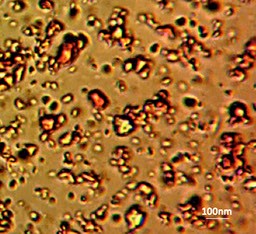
Commercial Cypermethrin 20%
- ANODS is by its very construction amphiphilic and has the capacity to transverse the barrier functions of the tree and thus is an excellent carrier for active agents. In the study where Cypermethrin was encapsulated in ANODS the formula was purposely sprayed onto the bark and insecticidal effect was observed as deep as 10cm into the tree. Deeper penetration was observed where green coloured ANODS was sprayed onto the trunk and traces of ANODS were observed in depths of 10,7cm.
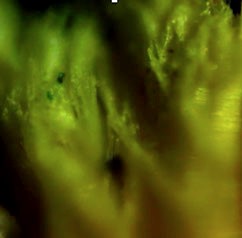
GREEN COLOURD ANODS AT A DEPTH OF 2.5CM.

GREEN COLOURED ANODS AT A DEPTH OF 10.7CM.
- Similarly, in fungi, the biggest general challenge for fungicidal products is to destroy the cell wall, which is generally regarded as impenetrable. This media below demonstrates how ANODS both penetrate through this wall and in another test completely destroy a Fusarium wall.
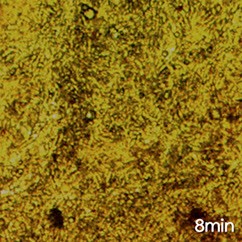
FUSARIUM TREATED WITH GP-AB AFTER 8 MIN.
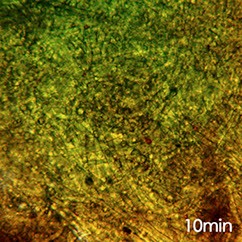
FUSARIUM TREATED WITH GP-AB AFTER 10 MIN. (NOTE CHANGE IN COLOUR)
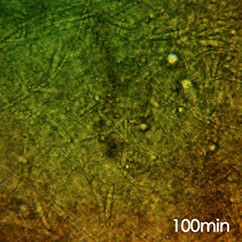
FUSARIUM TREATED WITH GP-AB AFTER 100 MIN (NOTE LESS FUSARIUM)
